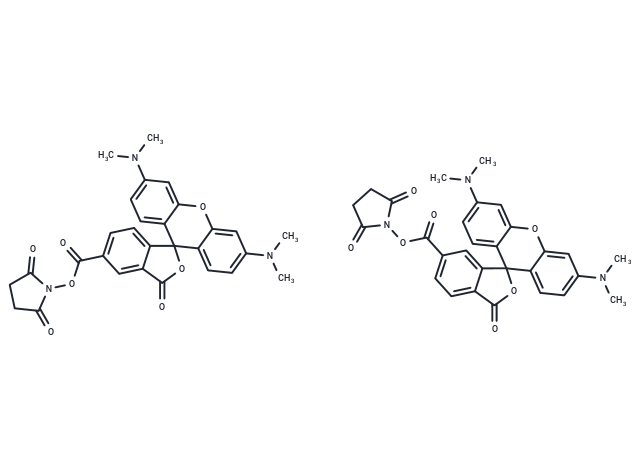Shopping Cart
Remove All Your shopping cart is currently empty
Your shopping cart is currently empty
5(6)-TAMRA SE (5(6)-Carboxytetramethylrhodamine N-succinimidyl ester) is the amine-reactive, mixed isomer form of TAMRA. 5(6)-TAMRA SE is a dye for oligonucleotide labeling and automated DNA sequencing applications.

| Pack Size | Price | USA Warehouse | Global Warehouse | Quantity |
|---|---|---|---|---|
| 5 mg | $42 | In Stock | In Stock | |
| 10 mg | $61 | In Stock | In Stock | |
| 25 mg | $97 | In Stock | In Stock | |
| 50 mg | $156 | In Stock | In Stock | |
| 100 mg | $249 | In Stock | In Stock | |
| 200 mg | $369 | - | In Stock | |
| 1 mL x 10 mM (in DMSO) | $59 | In Stock | In Stock |
| Description | 5(6)-TAMRA SE (5(6)-Carboxytetramethylrhodamine N-succinimidyl ester) is the amine-reactive, mixed isomer form of TAMRA. 5(6)-TAMRA SE is a dye for oligonucleotide labeling and automated DNA sequencing applications. |
| Cell Research | Instructions I. Reagent preparation: Select DMSO (e.g. 10 mM stock solution) or water, and adjust the specific concentration according to the experimental requirements. Generally, a dye concentration of 1–10 μM is used for labeling. II. Operation steps 1. Labeling process: 1) Prepare oligonucleotides: Select appropriate oligonucleotides and dissolve them, with a common concentration of 10–100 μM. Note: Ensure that the oligonucleotides are of good quality and are synthesized according to the experimental requirements. 2. Labeling reaction: 1) Add 5(6)-TAMRA SE solution to the oligonucleotide solution. A molar ratio of 1:10 to 1:100 is usually used. 2) The reaction is usually carried out within 30 minutes to 1 hour, and the reaction conditions are room temperature or slightly lower temperature (such as 4°C). 3) The reaction time and temperature can be optimized according to the needs of the experiment. 3. Reaction optimization: 1) The reaction can be carried out in phosphate buffered saline (PBS) or Tris buffer, maintaining the pH value between 7.0 and 8.5, which is helpful for labeling reaction. 2) If necessary, appropriate amount of chemical reagents (such as esterase or amino acid to prevent non-specific reaction) can be added to the reaction to optimize the labeling effect. 4. Removal of unbound dye: 1) After the reaction, unbound 5(6)-TAMRA SE needs to be removed. This can be done by the following methods: 2) Dialysis: Remove free dye in the solution by dialysis. 3) Gel filtration: Use gel filtration column to remove unbound dye. 4) Centrifugation: Separate the labeled oligonucleotide from the free dye by centrifugation. 5. Fluorescence detection: The labeled oligonucleotide can be detected by fluorescence. Measure the fluorescence signal using a fluorescence microscope, real-time PCR instrument, or other fluorescence imaging system: Excitation wavelength: 540 nm Emission wavelength: 595 nm 6. Data analysis: Based on the fluorescence intensity of the marker, the characteristics of the target DNA sequence, the binding efficiency of the probe, and the application of oligonucleotides in DNA sequencing can be analyzed. Notes: 1. Solubility: 5(6)-TAMRA SE has good solubility, but it is necessary to avoid exposing the dye to strong light during use to prevent the fluorescence signal from attenuating. 2. Nonspecific binding: During the labeling reaction, the concentration and reaction time of the dye should be controlled to avoid nonspecific binding of the dye to non-target molecules. 3. Storage: The dye should be kept away from light and usually needs to be stored at low temperature (-20°C) to maintain its stability. |
| Synonyms | 5(6)-Carboxytetramethylrhodamine N-succinimidyl ester |
| Molecular Weight | 527.53 |
| Formula | C29H25N3O7 |
| Cas No. | 246256-50-8 |
| Smiles | CN(C)c1ccc2c(Oc3cc(ccc3C22OC(=O)c3cc(ccc23)C(=O)ON2C(=O)CCC2=O)N(C)C)c1.CN(C)c1ccc2c(Oc3cc(ccc3C22OC(=O)c3ccc(cc23)C(=O)ON2C(=O)CCC2=O)N(C)C)c1 |
| Relative Density. | no data available |
| Storage | keep away from direct sunlight | Powder: -20°C for 3 years | In solvent: -80°C for 1 year | Shipping with blue ice/Shipping at ambient temperature. | |||||||||||||||||||||||||
| Solubility Information | DMSO: 25 mg/mL (47.39 mM), Sonication is recommended. | |||||||||||||||||||||||||
Solution Preparation Table | ||||||||||||||||||||||||||
DMSO
| ||||||||||||||||||||||||||
| Size | Quantity | Unit Price | Amount | Operation |
|---|

Copyright © 2015-2026 TargetMol Chemicals Inc. All Rights Reserved.